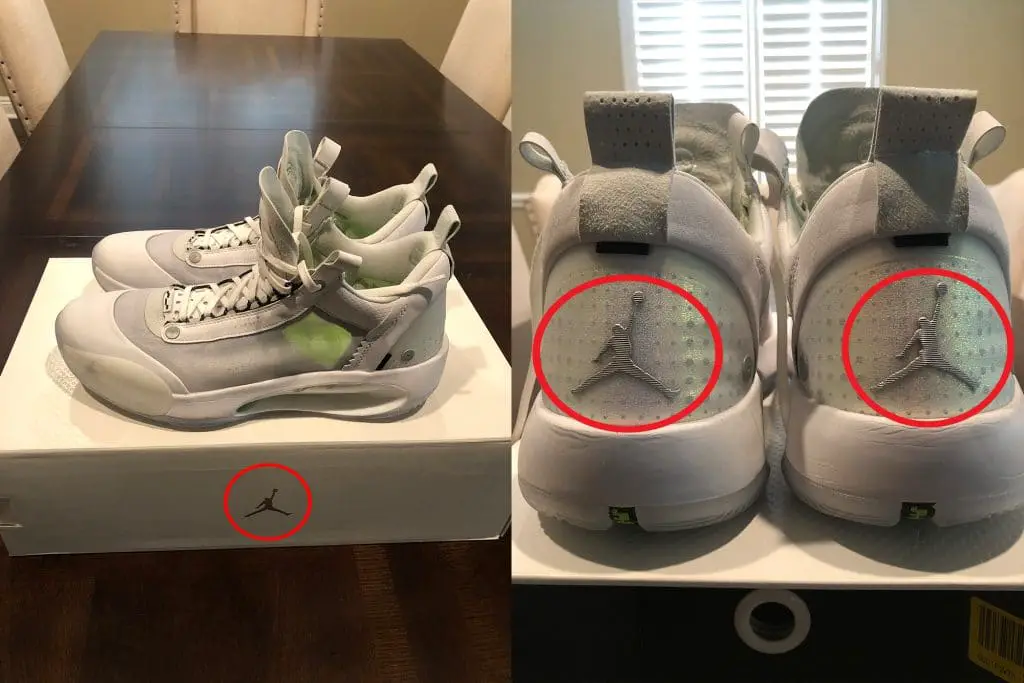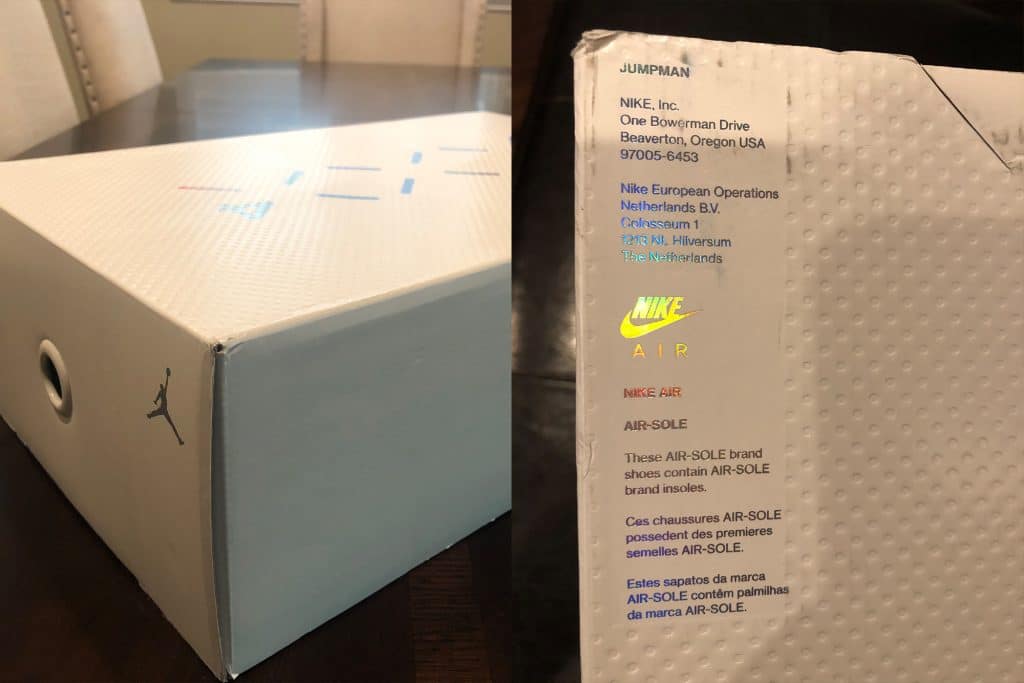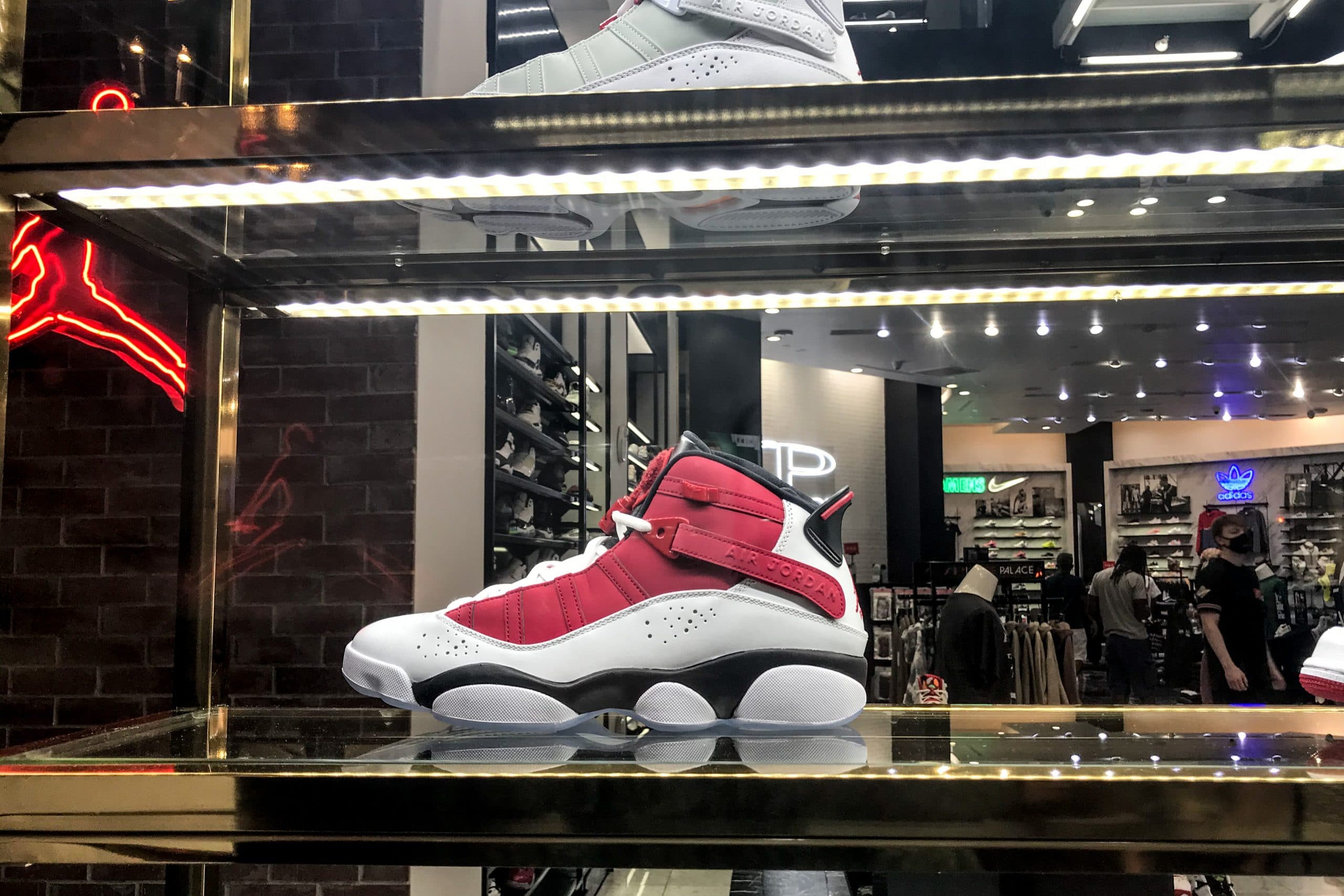Jordans are no doubt the most sought-after brand of basketball shoes in the world. When the first Jordan, Air Jordan I, debuted in 1984, it promptly changed the world of basketball shoes.
It transcended basketball shoes to become a fashion symbol and a cultural icon. So where are Jordans made?
Authentic Jordans are made in China, and most fake Jordans are also made in China. Nike’s cost to make a pair of authentic Jordan shoes is a little over $16, and they are sold on Amazon for $250-$550.
It is obvious how much fake Jordans may cost (lower than $16), and scammers will make a profit even if they mark up fake Jordans to only $25-$30.
Real Jordans cost around $115-$170. You can also find cheaper real Jordans under $100 and kids Jordans for $50-$65 on the official Nike website.
Interesting Read: How Much is Jordans Worth at Pawn Shops?
You can check the authenticity of Jordans by comparing the Jumpman logo. Fake Jumpman looks proportionally thicker, arms and legs are slightly facing the wrong angle. You can also inspect the shoe tag barcode to distinguish fake from real Jordans.
If You are looking for cheap but real Jordans, the best way is to look for Nike outlets and trusted marketplaces. Here is a list of places to look for:
- Nike.com Clearance Jordans Section
- Nike Factory Stores
- Nike Clearance Stores
- Final-Score
- Eastbay
- Finish Line
- Facebook Groups
- Sneaker Shows & Conventions
- eBay
Related: 9 Places You Can Buy Cheap Authentic Real Jordans
More than 3 decades after Air Jordan I’s debut, Jordan is bigger than ever. In 2019, Jordan Brand brought in over $3.1 billion in sales for Nike. On top of that, there is a huge resale market for Jordans.
The global sneaker resale market is now estimated to be worth more than $2 billion, with Jordan account for a big chunk of that.
With so much money on the line, it is not a surprise that a vast fake Jordan industry has sprung up to swindle money out of unsuspecting buyers.
These counterfeiters have become very sophisticated. Therefore, it is important to learn how to detect fake Jordans if you ever plan to buy Jordans.
Avoid Jordans that are unreasonably cheap. Check the quality of the shoebox. Make sure the shoe tag and the manufacturing sticker have the correct Nike style code and UPC number.
Do not buy Jordans on Alibaba or Aliexpress. Authentic Jordans are not $30.
Jumpman Logo

Look at the Jumpman logo both on the shoebox and the shoe. Compare them to an authentic Jumpman logo and make sure they look the same. Here is a comparison between real jumpman logo and fake jumpman logo.
Clean Edge
The Jumpman logo on real Jordans has a very clean edge and a high-quality look. On fake Jordans, the edge of the Jumpman logo can be fuzzy and messy with loose threads hanging out.
The Jumpman logo itself can also look cheap on fake Jordans.
Appropriate Color & Placement for the Model & Colorway
For different Jordan models and colorways, the Jumpman logo has different colors and is put in different places on the shoe.
To find the correct color and placement of the Jumpman logo, you can go online and search for photos of your Jordan model and colorway.
Compare the photos you have found with your Jordans to make sure the Jumpman logo on your shoe has the right color and is placed in the right place.
Here are some of the obvious fake jumpman logo:

If you want to see more obvious and vaguely resembling fake jumpman logo, here are some examples.
Shoebox Exterior

Real Jordans’ shoe boxes are sturdy and well-made. Go through the following checklist to make sure the shoebox is authentic:
- Different Air Jordan models come in different shoeboxes with different styles and colors. Go online and look up photos of the specific shoebox for your specific Jordan model. Make sure that matches the shoebox your Jordans came in.
- Make sure the shoebox lid fits tightly over the shoebox body without any gaps.
- The colors on the box should be uniform with no faded areas.
- There should be Air Jordan Jumpman logos on the lid and the side of the box.
Shoebox Sticker

All authentic Jordans come in a box that has a manufacturing sticker on its side. Check that sticker and make sure:
- The information on the sticker (shoe model name, shoe size, color combo, country of origin) matches that of your shoes.
- The text on the sticker is properly spelled and printed.
- The sticker itself is in a perfect rectangular shape and is attached smoothly to the box, with no air bubbles underneath.
- The Nike style code on the sticker is correct.
- The Nike style code is a 9 digit number printed on the manufacturing sticker. It is in 2 groups: a 6 digit group followed by a 3 digit group.
- For example, the Nike Style Code of Air Jordan 4 Retro Laser 30th Anniversary is 705333 105
- Go to websites such as StockX or Barcode Spider, type in the name of your Jordan model to find out its corresponding Nike style code.
- Make sure that Nike style code matches the Nike style code printed on the manufacturing sticker.
- Unfortunately, not one single site has all the Jordan models and editions and colorways in its database. So you may have to check several sites.
- The UPC number on the sticker is correct.
- The UPC number is the 12 or 13 digit number printed on the sticker right underneath a barcode.
- For example, the UPC number of Air Jordan 4 Retro Laser “30th Anniversary” is 888408148209
- Go to the website Barcode Spider, type in the name of your Jordan model to find out its corresponding UPC number.
- Make sure that the UPC number matches the UPC number printed on the manufacturing sticker.
Shoe Tag

Look for a tag that is sewn inside the shoe. It should have a size and a Nike-style code printed on it. Make sure they match the actual size and Nike style code of your shoe.
The tag of a Jordan can typically be found behind the shoe tongue or on the side of the shoe.
Real Jordan’s shoe tag is a 9 digit number, which is the same number displayed on the box’s side in the manufacture label with the logo on top of the number.
There are a few ways to tell a real Jordan from a fake Jordan based on its size tag:
- Border: The size tag is framed by a white border. On real Jordans, this white frame is made of a dense material that is thick. On fake Jordan, the frame material tends to be thinner and more flimsy
- Font: On real Jordans, the size tag uses a cleanly printed font with well-defined edges. On fake Jordans, the font has lower quality printing with smudged and fuzzy edges
- Barcode: Similarly, the size tag on real Jordans has a cleanly printed barcode. For fake Jordans, the size tag’s barcode tend to have smeared edges
Related: Does Nike Run Big or Small? Complete Nike Shoe Fit List
Model & Colorway
Go to Google to search the model name and colorway of your Jordans. If you can’t find it online, your shoes are fake.
Look up Nike Style Code on Size Tag
On the size tag inside your Jordan, you can find the Nike Style Code of your shoe. It is a 9-symbol long code printed in 2 groups – a 6-symbol group followed by a 3-symbol group.
The symbols can either be alphabets or numbers. Depending on the specific model of your Jordan, the 2 groups of symbols may or may not be separated by a dash “-”.
As an example, the Nike Style Code of Air Jordan 11 Retro Jubilee 25th Anniversary in the Black / Multi-color-white-multicolor colorway is CT8012-011
Look up Model & Colorway Information on Online Database
Go to websites such as StockX or GOAT, type in the Nike Style Code from Step 1 to find out its corresponding Model and Colorway.
Verify Shoe Appearance
The online databases such as StockX or GOAT will also give you photos of the Jordan you are looking up.
Compare those photos with your Jordans to make sure your shoes have the right appearance. This is a good way to verify the model and colorway of your Jordans
Verify Model & Colorway Information on Shoebox Sticker
All authentic Jordans should come in a shoebox that has a manufacturing sticker on its side. On this sticker, you will find information pertaining to the shoe’s model, colorway, Nike Style Code, size, and country of origin.
Compare the Nike Style Code you found in Step 1 with the Nike Style Code on the shoebox sticker. Make sure the two match with each other.
Repeat the same process with the model & colorway you found in Step 2. Make sure they match the model and colorway printed on the shoebox sticker
Stitching
The stitching on your shoes should be of the highest quality – evenly spaced, no loose ends, no frayed threads. Make sure the Jumpman logo on your shoe is well-made with a well-defined (not blurry) edge.
Uniformity
The stitching on real Jordans is uniformly done and evenly spaced. On fake Jordans, the stitching can be messy and the gap between each stitch can be inconsistently spaced
Symmetry
On real Jordans, the stitching is symmetric on both the left shoe and the right shoe. On fake Jordans, you may see different stitching on different shoe
Appropriate for the Model & Colorway
The pattern and color of the stitching on your Jordan should match the model and colorway of your shoe.
Type in your shoe’s model and colorway at an online sneaker database such as StockX or GOAT to get a photo of that shoe.
Compare the stitching on the shoe in the photo with the stitching on your shoe. If the stitching patterns and colors on the 2 shoes do not match, your shoe is not authentic
Barcode
On the size tag inside your Jordan or the shoebox sticker on your Jordan’s shoebox, you will find a barcode. Underneath the barcode is a 12-digit UPC that corresponds to the barcode.
This barcode (and its corresponding UPC) is different for each combination of shoe model, colorway, and size. So, for example:
- The model “Air Jordan 1 Retro High OG” in the colorway “2017 Royal” in the size 12 has the UPC 887223097945
- The same model “Air Jordan 1 Retro High OG” in a different colorway “Shattered Backboard” in the size 9.5 has the UPC 885259842287
To verify the barcode on your Jordan:
- Find the UPC underneath the barcode on the size tag inside your Jordan
- Go to a barcode lookup website such as Barcode Lookup. Type in the UPC you found in Step 1
- The barcode lookup website will give you the shoe model, colorway, and size combination that corresponds to the UPC you have entered
- Make sure this model, colorway, and size combination matches the actual model, colorway, and size of your Jordan
How to Find Out Which Jordan You Have
To find out the model and colorway of the Jordan you have, look up the 12-digit UPC printed on the size tag inside your shoe.
Then, you can enter that UPC into an online barcode database such as Barcode Lookup.
The online barcode database will give you the model and colorway of the Jordan you have based on the UPC you entered
List of Real Jordans Websites

If you have to buy from unauthorized sources, exercise great caution to check if your Jordans are fake. Avoid shoes that are unreasonably cheap. Make sure the colorway you are buying actually exists.
Check the shoebox, the manufacturing sticker, the shoe tag, the Jumpman logo, and the stitching to look for any telltale signs of fake products. If you follow the steps in this article, you will cut down your chance of getting fake Jordans substantially.
The best way to buy discounted Jordans is to buy from the Nike website, Nike stores, or authorized retailers. (at least to avoid overseas or low-rated/new sellers.)
Discounted authentic Jordans on Nike:
Discounted authentic Jordans on other market place:
List of Nike Authorized Retailers
The best way to avoid fake Jordans is to buy from Nike. If you get your Jordans from the Nike website or a Nike store, you are guaranteed to be getting authentic shoes. Next best is to buy from a Nike authorized retailer.
Nike does not provide a list of authorized retailers to the public. Consumers normally would have to contact Nike directly to confirm whether a specific retailer you have in mind is an authorized dealer or not.
To save you some time, here is a partial list of major companies that are known as authorized Nike retailers:
- Zappos
- Eastbay
- Footlocker
- Champs Sports
- Footaction
- Finish Line
One notable absence from this list is Amazon. Many people assume that when they buy from a company as big as Amazon, they will not get fake products.
That is no true at all. Most of the products on sale on Amazon are not being sold by Amazon itself.
Instead, most products are being sold by 3rd party sellers who may or may not be selling fake products.
And even if you are buying a product that is designated as being “Sold by Amazon,” you can still end up with a fake product.
That is because of an Amazon practice known as “inventory commingling” – under which, even if you buy directly from Amazon, Amazon may still ship you a product drawn from the inventory of a 3rd party seller.
So, if that 3rd party seller sells fake products, you will get fake products.
This problem got so bad on Amazon that Nike stopped selling on Amazon in 2019 because of the rampant counterfeiting there:
“Nike is pulling out of (Amazon) after it struggled to control the Amazon marketplace. Third-party sellers whose listings were removed simply popped up under a different name.”
Tip: If you are buying from a marketplace such as eBay or Amazon Marketplace, check the seller’s feedback ratings. Only buy from sellers with an established history (1+ year selling, 100+ buyer feedback) and a high overall rating (> 95% positive).
Related: Top 25 Best Basketball Shoes for Guards | Forwards | Centers
Fake Jordans Market Stats
As mentioned, Jordans are big business. In 2019, Jordan Brand was a $3.1 billion business for Nike. For the 4th quarter of 2019, Jordan Brand just earned its first $1 billion quarter.
Those numbers were wholesale revenues. Retail revenues will be significantly bigger.
| Year | 2015 | 2016 | 2017 | 2018 | 2019 |
| Nike revenue from Jordan Brand | $2.33 billion | $2.75 billion | $3.10 billion | $2.96 billion | $3.14 billion |
There is also a huge and booming resale market for Jordans, complete with eye-popping prices. Some of the most in-demand Jordan models have been selling for between $9,000 and $38,000 on StockX.
Many people are actively buying and selling Jordans as an investment. All told, Jordans are at the heart of a $2 billion a year sneaker resale market in 2020 that is predicted to explode to $6 billion per year by 2025.
Unfortunately, this booming demand for Jordans has created a big incentive for criminals to make fake Jordans. And fake Jordans have become a big business. Just recently:
- Aug 2018: 5 people charged with trafficking $73 million in fake Air Jordan sneakers, importing nearly 500,000 pairs of fake Air Jordans from China through the Port of Newark in New Jersey.
- Oct 2019: Almost 15,000 pairs of fake Air Jordans and fake Nikes from China were seized by Customs and Border Protection agents at the Port of Los Angeles / Long Beach.
- Jan 2020: An international counterfeiting ring was busted for shipping more than $472 million worth of fake sneakers including fake Nikes from China into the United States.
As you can see, fake Jordans are by no means a small problem. So do not let your guard down. Make sure you have done the due diligence before you buy your next pair of Jordans.

Austin is the author of loveatfirstfit.com and a personal trainer with extensive knowledge in nutrition. Austin is passionate about helping others to find a suitable healthy lifestyle and feel good about themselves. Austin’s goal is to help people push their limits and achieve their physical performance.

